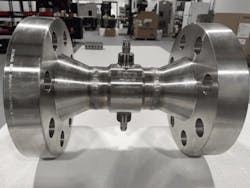Comparing in-line and clamp-on flowmeters: Pros and cons

Flowmeters play a critical role in measuring liquid flow rates across industries, from water treatment to oil and gas. Two of the most common types are in-line flowmeters and clamp-on flowmeters. While both serve the same fundamental purpose, they differ significantly in installation, accuracy, cost and application suitability. This article compares their pros and cons to help you determine the best option for your needs.
What are in-line and clamp-on flowmeters?
In-line flowmeters
In-line flowmeters are installed directly within a pipeline, requiring the pipe to be cut and fitted with the meter. These meters come in various technologies, such as turbine, electromagnetic, ultrasonic and Coriolis, depending on the specific application and fluid type.
Clamp-on flowmeters
Clamp-on flowmeters use ultrasonic sensors that attach externally to a pipe, measuring flow by sending and receiving sound waves through the fluid. Since they do not require direct contact with the liquid, installation is non-intrusive and does not require cutting into the pipeline.
Pros and cons of in-line flowmeters
Pros of in-line flowmeters
- High accuracy – Since in-line meters are in direct contact with the fluid, they provide precise and consistent measurements with minimal interference.
- Versatile technology options – Available in multiple types (e.g., turbine, magnetic, Coriolis, and positive displacement), making them suitable for various industries.
- Reliable for low flow rates – More effective in measuring low-flow applications than clamp-on meters, particularly in chemical and pharmaceutical industries.
- Long-term durability – Typically built with rugged materials to withstand harsh environments, extreme temperatures and high pressures.
Cons of in-line flowmeters
- Complex installation – Requires cutting into pipes, shutting down operations and potentially modifying infrastructure, which increases downtime and labor costs.
- Higher maintenance requirements – Depending on the meter type, in-line models may need regular cleaning and calibration, especially in applications with dirty or corrosive fluids.
- More expensive upfront costs – The need for professional installation and potential system modifications can make them costlier than clamp-on alternatives.
Pros and cons of clamp-on flowmeters
Pros of clamp-on flowmeters
- Non-invasive installation – Easily attaches to the exterior of the pipe, eliminating the need for system shutdowns or pipeline modifications.
- Cost-effective solution – Reduced labor costs and minimal installation time make it a more affordable option, especially for temporary or portable flow measurements.
- Ideal for hard-to-access locations – Suitable for applications where in-line installation would be impractical or too disruptive.
- Low maintenance – Since they do not come into contact with the fluid, they are less prone to wear, corrosion and clogging.
Cons of clamp-on flowmeters
- Lower accuracy compared to in-line meters – External mounting can lead to measurement discrepancies, especially in pipes with irregular flow conditions or varying liquid compositions.
- Limited performance on small pipes – Clamp-on meters work best with medium to large-diameter pipes; their accuracy decreases for smaller pipe sizes.
- Dependence on pipe material and condition – Performance can be affected by pipe thickness, material and surface conditions, potentially requiring adjustments or additional calibration.
Which flowmeter is right for your application?
Choose in-line flowmeters if:
- You require high-precision measurements.
- Your application involves low flow rates or viscous fluids.
- You need a long-term, durable solution for demanding industrial environments.
- Shutdowns for installation and maintenance are not a major concern.
Choose clamp-on flowmeters if:
- You need a quick, non-intrusive installation without process downtime.
- Your application involves temporary, portable, or retrofit flow measurement needs.
- Cost-effectiveness and ease of maintenance are priorities.
- Your system includes large-diameter pipes that are difficult to modify.
Final thoughts
Both in-line and clamp-on flowmeters have their advantages and drawbacks. The best choice depends on your specific needs, including accuracy, budget, installation feasibility and long-term maintenance considerations. If your application demands high precision and reliability, in-line meters may be the better choice. However, if you need a flexible and non-invasive solution, clamp-on meters offer significant benefits.
Still unsure? Consult with a flowmeter expert to determine the best option for your unique requirements.
About the Author
Mark Weiss
Marketing Specialist, Turbines, Inc.
Mark Weiss is a marketing specialist at Turbines, Inc.